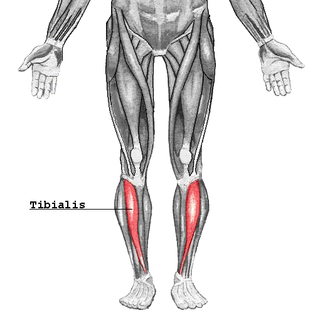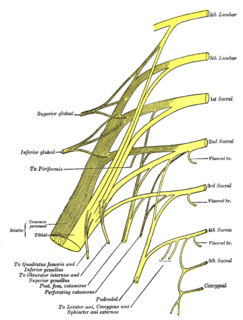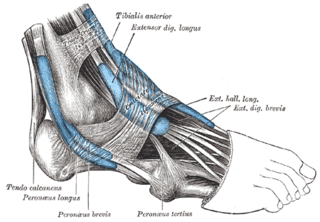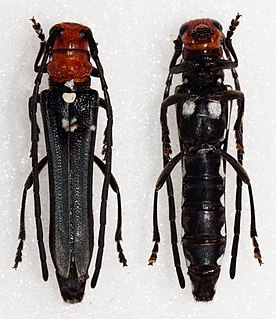Related Research Articles

In the human body, the cuboid bone is one of the seven tarsal bones of the foot.

The extensor hallucis longus muscle is a thin skeletal muscle, situated between the tibialis anterior and the extensor digitorum longus. It extends the big toe and dorsiflects the foot. It also assists with foot eversion and inversion.

The tibialis posterior muscle is the most central of all the leg muscles, and is located in the deep posterior compartment of the leg. It is the key stabilizing muscle of the lower leg.

The tibialis anterior muscle is a muscle in humans that originates along the upper two-thirds of the lateral (outside) surface of the tibia and inserts into the medial cuneiform and first metatarsal bones of the foot. It acts to dorsiflex and invert the foot. This muscle is mostly located near the shin.

The tibial nerve is a branch of the sciatic nerve. The tibial nerve passes through the popliteal fossa to pass below the arch of soleus.

The flexor digitorum longus muscle is situated on the tibial side of the leg. At its origin it is thin and pointed, but it gradually increases in size as it descends. It serves to flex the second, third, fourth, and fifth toes.

The extensor digitorum longus is a pennate muscle, situated at the lateral part of the front of the leg.

The inferior extensor retinaculum of the foot is a Y-shaped band placed in front of the ankle-joint, the stem of the Y being attached laterally to the upper surface of the calcaneus, in front of the depression for the interosseous talocalcaneal ligament; it is directed medialward as a double layer, one lamina passing in front of, and the other behind, the tendons of the peroneus tertius and extensor digitorum longus.

The anterior compartment of the leg is a fascial compartment of the lower limb. It contains muscles that produce dorsiflexion and participate in inversion and eversion of the foot, as well as vascular and nervous elements including the anterior tibial artery and veins, and the deep fibular nerve.

The white-thighed swallow is a species of bird in the family Hirundinidae. It was formerly placed in the monotypic genus, Neochelidon.

Leuconitocris is a genus of longhorn beetles of the subfamily Lamiinae, containing the following species:
Leuconitocris obereoides is a species of beetle in the family Cerambycidae. It was described by Stephan von Breuning in 1956.
Leuconitocris microphthalma is a species of beetle in the family Cerambycidae. It was described by Stephan von Breuning in 1950, originally under the genus Nitocris. It is known from Sierra Leone and the Democratic Republic of the Congo.
Leuconitocris argyrostigma is a species of beetle in the family Cerambycidae. It was described by Per Olof Christopher Aurivillius in 1914.
Leuconitocris argenteovittata is a species of beetle in the family Cerambycidae. It was described by Per Olof Christopher Aurivillius in 1914.

Leuconitocris leucostigma is a species of beetle in the family Cerambycidae. It was described by Harold in 1878. It has a wide distribution in Africa.
Leuconitocris buettneri is a species of beetle in the family Cerambycidae. It was described by Hermann Julius Kolbe in 1893.
Leuconitocris nigricornis is a species of beetle in the family Cerambycidae. It was described by Olivier in 1795, originally under the genus Necydalis. It is known from Tanzania, South Africa, the Central African Republic, Mozambique, Uganda, Malawi, and Zambia.
Leuconitocris schultzei is a species of beetle in the family Cerambycidae. It was described by Hintz in 1919.
Gettyia is an extinct genus of avisaurid enantiornithean bird from the Late Cretaceous of North America.
References
- ↑ BioLib.cz - Leuconitocris tibialis. Retrieved on 8 September 2014.